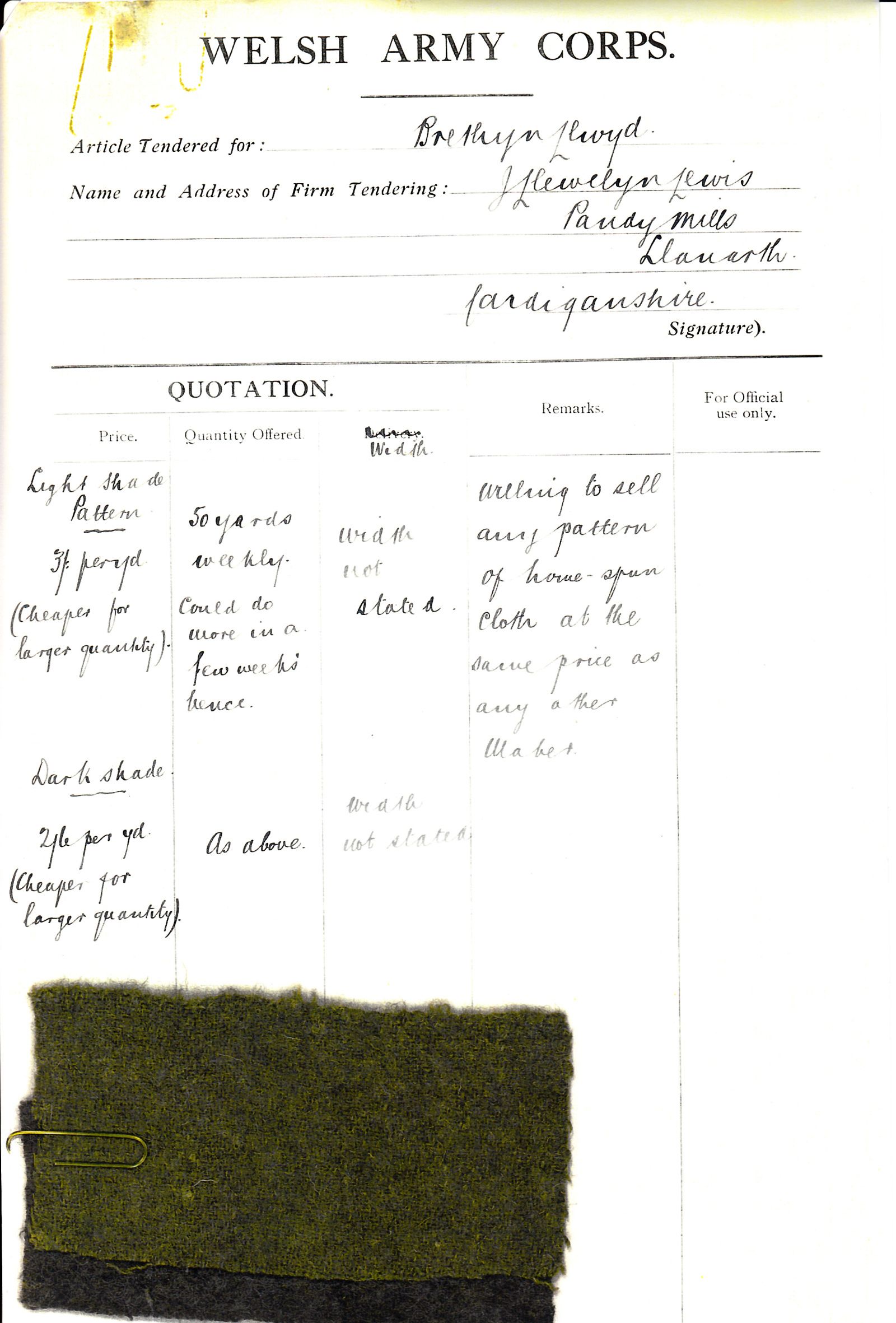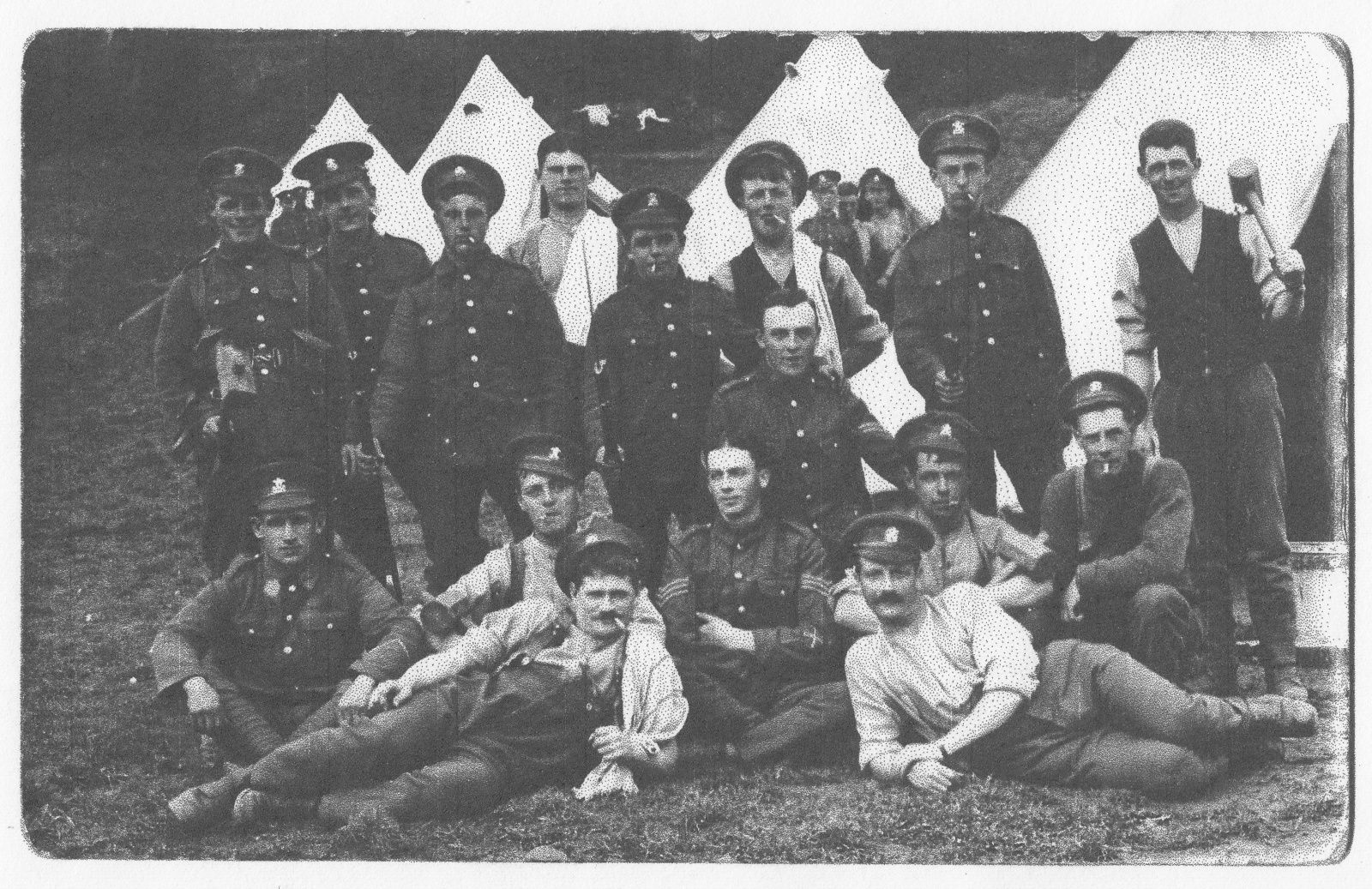Brethyn Llwyd
Lloyd George’s poetic idea
'I should like to see a Welsh army in the field. I should like to see the race that faced the Norman for hundreds of years in struggle for freedom, the race that helped to win Crecy, the race that fought for a generation under Glyndwr against the greatest captain in Europe. I should like to see that race give a good taste of their quality in this struggle in Europe and they are going to do it'
On 29 September 1914 the Welsh National Executive Committee was formed to recruit a Welsh Army Corps of 40,000 to 50,000 men. The recruitment was based on the Corps's unique Welshness, with the encouragement of Welsh-speaking officers and Welsh-language recruitment posters.
Equipment Shortage
Due to the rapid expansion, the British Army faced a severe shortage of uniforms and equipment. To overcome the shortage the Committee decided in October 1914 to reinforce the national identity of the Welsh Army Corps by tendering for Welsh Grey homespun cloth “Brethyn Llwyd” for uniforms from the woollen manufacturers of Wales.
David Morgan of Cardiff was the main contractor, with all finished material sent to their offices in Cardiff before being made into uniforms by Messrs Masters. The woollen manufacturers of Wales were in desperate need of these new contracts as the industry was in decline due to worker unrest and competition from the larger mills of Northern England.
Production problems
There were early supply problems from the woollen manufacturers; Brethyn Llwyd is made by blending fleece from black and white sheep. Each mill had its own unique colour for Brethyn Llwyd; they therefore sent samples to the Committee to agree the colour.
The cloth produced by the mills was sent to Bristol for finishing and returned to Cardiff adding to the cost and time to make a complete uniform. A Brethyn Llwyd jacket was more expensive than traditional khaki, a Brethyn Llwyd jacket cost almost £1 and a khaki Jacket cost 14s 6d.
Factories re-equipped
By 1915 the mills were being re-equipped in anticipation of large orders for Brethyn Llwyd. Cambrian Mills Dre-fach Felindre (Now the National Wool Museum) built a new weaving shed, other mills invested in new equipment and staff. David Lewis of Cambrian Mills claimed he was able to produce 3,500 yards of cloth a week in February 1915 enough for 1,200 uniforms.

Demise of Brethyn Llwyd
Unfortunately this increased capacity came too late and production of Brethyn Llwyd was short-lived due to extra cost and the now ready availability of Khaki forcing the Committee to only order 8,440 uniforms in Brethyn Llwyd. The mill owners sent many letters to the Committee pleading for orders. Brethyn Llwyd uniforms never saw active service but due to their hard wearing qualities the uniforms were re-used repeatedly by the Reserves at Kinmel Park Camp until at least November 1916. In August 1915 the War Office took over the Welsh National Executive Committee, the raised units were formed into the 38th Welsh Division and the dream of a Welsh Corps vanished.
Supplying the Allies
Brethyn Llwyd was not the only war contract for woollen manufactures of Wales, woollen manufactures across Wales produced blankets for the army. One of the largest orders was secured by Ben Evans of Swansea for 15,000 blankets.
Welsh woollen manufactures also secured orders from foreign governments, for example in 1917 the Romanian Army ordered large quantities of Welsh flannel. The North Wales stocking industries supplied 300,000 pairs of socks to the allies during the war although these contracts only benefitted the larger manufactures.
Labour Shortage
With conscription of men into the army mill owners struggled for labour, before the war unlike English mills Welsh mills employed predominately men and the weavers worked one man one loom. The weavers threatened to strike over pay finally resolved with the intervention from the War Office in favour of higher wages but for more output.
Mill owners attended tribunals arguing for their workers not to be conscripted into the army because they could not be replaced, women preferred to work in the munitions factories and other heavy industries for higher wages than work in the woollen mills.

Weavers at war
Many workers from the mills volunteered for the army or were conscripted. Willie Evans worked at Cambrian Mills Drefach Felindre, he joined the royal artillery serving on the western front and in Russia, Willie returned to Cambrian mills after the war.
David Emlyn Jones was a weaver at Ogof Mill Cwmpengraig he was conscripted into the army in 1917 to the Welsh regiment. David was killed on sentry duty on the Western front 12th December 1917 he left behind 4 children including a baby that he never met. David's last letter home, written in Welsh arrived after the letter in English informing his wife of his death.
Post war decline and fires
'[Mill owners who made vast profits from war contracts] made no attempt to set their mills on a sound financial basis, content to bank the money or buy seaside cottages'
Geraint Jenkins 1967, the Welsh Woollen Industry, p. 278
After the war 12 million yards of surplus flannel was sold on the open market by the government at ridiculously low prices forcing woollen manufactures to also cut their prices. Flannel shirts for example sold at 52s 6d a dozen in 1916 by 1923 the price had dropped to 38 shillings. In Dre-fach Felindre 21 factories closed and 7 more burnt to the ground including Cambrian Mills, arson was suspected but never proven.
Unfortunately no Brethyn Llwyd uniform has been found, all that exists are the samples sent by woollen manufactures to the committee to decide the final colour, the choice they made remains a mystery. The samples are now part of the Welsh Army Corp collection held at the National Library of Wales.
